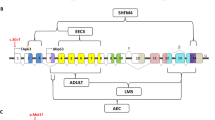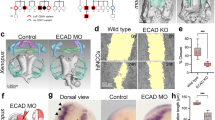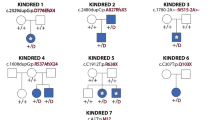Abstract
Cleft lip, with or without cleft palate (CL/P), is one of the most common birth defects, occurring in 0.4 to 2.0 per 1,000 infants born alive1. Approximately 70% of CL/P cases are non-syndromic (MIM 119530), but CL/P also occurs in many single-gene syndromes, each affecting a protein critical for orofacial development. Here we describe positional cloning of the gene responsible for an autosomal recessive CL/P-ectodermal dysplasia (ED) syndrome (CLPED1; previously ED4; ref. 2), which we identify as PVRL1, encoding nectin-1, an immunoglobulin (Ig)-related transmembrane cell-cell adhesion molecule that is part of the NAP cell adhesion system3,4,5,6. Nectin-1 is also the principal cell surface receptor for α-herpesviruses (HveC; ref. 7), and the high frequency of CLPED1 on Margarita Island in the Caribbean Sea might result from resistance of heterozygotes to infection by these viruses.
This is a preview of subscription content, access via your institution
Access options
Subscribe to this journal
Receive 12 print issues and online access
$209.00 per year
only $17.42 per issue
Buy this article
- Purchase on Springer Link
- Instant access to full article PDF
Prices may be subject to local taxes which are calculated during checkout



Similar content being viewed by others
References
Schutte, B.C. & Murray, J.C. The many faces and factors of orofacial clefts. Hum. Mol. Genet. 8, 1853–1859 (1999).
Suzuki, K., Bustos, T. & Spritz, R.A. Linkage disequilibrium mapping of the gene for Margarita Island ectodermal dysplasia (ED4) to 11q23. Am. J. Hum. Genet. 63,1102–1107 (1998).
Takahashi, K. et al. Nectin/PRR: an immunoglobulin-like cell adhesion molecule recruited to cadherin-based adherens junctions through interaction with Afadin, a PDZ domain-containing protein. J. Cell Biol. 139, 517–549 (1999).
Mandai, K. et al. Afadin: a novel actin filament-binding protein with one PDZ domain localized at cadherin-based cell-to-cell adherens junction. J. Cell Biol. 139, 517–528 (1997).
Mandai, K. et al. Ponsin/SH3P12: an l-afadin- and vinculin-binding protein localized at cell-cell and cell-matrix adherens junctions. J. Cell Biol. 144, 1001–1017 (1999).
Asakura, T. et al. Similar and differential behaviour between the nectin-afadin-ponsin and cadherin-catenin systems during the formation and disruption of the polarized junctional alignment in epithelial cells. Genes Cells 4, 573–581 (1999).
Geraghty, R.J., Krummenacher, C., Cohen, G.H., Eisenberg, R.J. & Spear, P.G. Entry of alphaherpesviruses mediated by poliovirus receptor-related protein 1 and poliovirus receptor. Science 280,1618–1620 (1998).
Zlotogora, J., Zilberman, Y., Tenenbaum, A. & Wexler, M.R. Cleft lip and palate, pili torti, malformed ears, partial syndactyly of fingers and toes and mental retardation. A new syndrome? J. Med. Genet. 24, 291–293 (1987).
Ogur, G. & Yüksel, M. Association of syndactyly, ectodermal dysplasia, and cleft lip and palate: report of two sibs from Turkey. J. Med. Genet. 25, 37–40 (1988).
Zlotogora, J. & Ogur, G. Syndactyly, ectodermal dysplasia, and cleft lip and palate. J. Med. Genet. 25, 503 (1988).
Rodini, E.S.O. & Richieri-Costa, A. Autosomal recessive ectodermal dysplasia, cleft lip/palate, mental retardation, and syndactyly: the Zlotogora-Ogur syndrome. Am. J. Med. Genet. 36, 473–476 (1990).
Zlotogora, J. Syndactyly, ectodermal dysplasia, and cleft lip/palate. J. Med. Genet. 31, 957–959 (1994).
Bustos, T. et al. Autosomal recessive ectodermal dysplasia: I. An undescribed dysplasia/malformation syndrome. Am. J. Med. Genet. 41, 398–404 (1991).
Buckler, A.J. et al. Exon amplification: a strategy to isolate mammalian genes based on RNA splicing. Proc. Natl Acad. Sci. USA 88, 4005–4009 (1991).
Altschul, S.F. et al. Gapped BLAST and PSI-BLAST: a new generation of protein database search programs. Nucleic Acids Res. 25, 3389–3402 (1997).
Leonhardt, E.A., Kapp, L.N., Young, B.R. & Murnane, J.P. Nucleotide sequence analysis of a candidate gene for ataxia-telangiectasia group D (ATDC). Genomics 19, 130–136 (1994).
Lee, S.-T., Park, S.-K., Lee, K.-H., Holmes, S.A. & Spritz, R.A. A non-radioactive method for simultaneous detection of single-strand conformation polymorphisms (SSCPs) and heteroduplexes. Molecules Cells 5, 668–672 (1995).
Lopez, M. et al. Complementary DNA characterization and chromosomal localization of a human gene related to the poliovirus receptor-encoding gene. Gene 155, 261–265 (1995).
Cocchi, F. et al. The V domain of herpesvirus Ig-like receptor (HIgR) contains a major functional region in herpes simplex virus-1 entry into cells and interacts physically with the viral glycoprotein D. Proc. Natl Acad. Sci. USA 95, 15700–15705 (1998).
Celli, J. et al. Heterozygous germline mutations in the p53 homolog p63 are the cause of EEC syndrome. Cell 99, 143–153 (1999).
van den Boogaard, M.-J.H., Dorland, M., Beemer, F.A. & van Amstel, H.K.P. MSX1 mutation is associated with orofacial clefting and tooth agenesis in humans. Nature Genet. 24, 342–343 (2000).
Mendelsohn, C.L., Wimmer, E. & Racaniello, V.R. Cellular receptor for poliovirus: molecular cloning, nucleotide sequence, and expression of a new member of the immunoglobulin superfamily. Cell 56, 855–865 (1989).
Koike, S. et al. The poliovirus receptor protein is produced both as membrane-bound and secreted forms. EMBO J. 9, 3217–3224 (1990).
Eberle, F., Dubreuil, P., Mattei, M.G., Devilard, E. & Lopez, M. The human PRR2 gene, related to the human poliovirus receptor gene (PVR), is the true homolog of the murine MPH gene. Gene 159, 267–272 (1995).
Schonk, D. et al. Assignment of seven genes to distinct intervals on the midportion of human chromosome 19q surrounding the myotonic dystrophy gene region. Cytogenet. Cell Genet. 54, 15–19 (1990).
Trask, B. et al. Fluorescence in situ hybridization mapping of human chromosome 19: cytogenetic band location of 540 cosmids and 70 genes or DNA markers. Genomics 15, 133–145 (1993).
Stein, J. et al. Nonsyndromic cleft lip with or without cleft palate: evidence of linkage to BCL3 in 17 multigenerational families. Am. J. Hum. Genet. 57, 257–272 (1995).
Amos, C., Gasser, D. & Hecht, J.T. Nonsyndromic cleft lip with or without cleft palate: new BCL3 information. Am. J. Hum. Genet. 59, 743–744 (1996).
Wyszynski, D.F. et al. Evidence for an association between markers on chromosome 19q and non-syndromic cleft lip with or without cleft palate in two groups of multiplex families. Hum. Genet. 99, 22–26 (1997).
Helms, J.A. et al. Sonic hedgehog participates in craniofacial morphogenesis and is down-regulated by teratogenic doses of retinoic acid. Dev. Biol. 186, 25–35 (1997).
Acknowledgements
We thank C. Jones for PAC p32o11; and D. Shukla and P.G. Spear for the unpublished mouse Pvrl1 cDNA sequence. This work was supported by grants from the March of Dimes Birth Defects Foundation (FY99-609) and the National Foundation for Ectodermal Dysplasia to R.A.S. and the National Institutes of Health (HD01079, DE12462) to J.A.H.
Author information
Authors and Affiliations
Corresponding author
Rights and permissions
About this article
Cite this article
Suzuki, K., Hu, D., Bustos, T. et al. Mutations of PVRL1, encoding a cell-cell adhesion molecule/herpesvirus receptor, in cleft lip/palate-ectodermal dysplasia. Nat Genet 25, 427–430 (2000). https://doi.org/10.1038/78119
Received:
Accepted:
Issue Date:
DOI: https://doi.org/10.1038/78119
This article is cited by
-
Loss of NECTIN1 triggers melanoma dissemination upon local IGF1 depletion
Nature Genetics (2022)
-
Impact of low-frequency coding variants on human facial shape
Scientific Reports (2021)
-
Precise levels of nectin-3 are required for proper synapse formation in postnatal visual cortex
Neural Development (2020)
-
Genomic and functional analysis of the host response to acute simian varicella infection in the lung
Scientific Reports (2016)
-
Tooth agenesis and orofacial clefting: genetic brothers in arms?
Human Genetics (2016)



